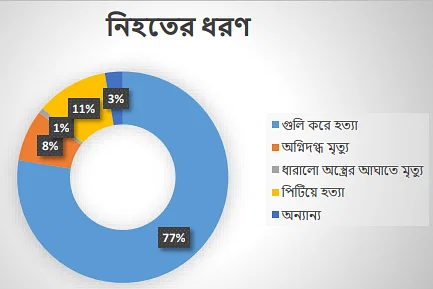Between July 16 and September 9, a total of 875 people were killed during the quota reform movement and the student-public uprising. A significant number of these deaths resulted from gunfire. In the seven days spanning July 18-20 and August 4-7 alone, 748 people lost their lives. Additionally, more than 30,000 individuals were injured in the uprising.
The Human Rights Support Society (HRSS) gathered this information by analyzing data related to the casualties during the anti-discrimination student movement and the broader uprising. The data was collected from a variety of sources, including 12 national newspapers, HRSS’s investigative unit, and volunteer reports from across the country.
In a press release issued today, HRSS shared this review report. It highlighted that their findings, based on media reports, hospital records, and other credible sources, suggest the death toll may be at least 1,000.
On August 5, amidst the uprising, Prime Minister Sheikh Hasina’s government was overthrown, and she fled to India.
HRSS’s report analyzed the victims’ ages, occupations, and causes of death. It stated that from July 16 to August 3, 327 people were killed, and from August 4 to September 9 (some of whom later died from their injuries), another 548 lost their lives. Among the dead, 77% were shot. The majority of the victims (53%) were between the ages of 19 and 30. Overall, 70% of those killed were under 30. Students comprised the largest group of victims, accounting for 52%. Most deaths occurred due to gunfire or police violence.
The report also revealed that the ruling party’s student wing, Chhatra League, was directed to attack protesting students. Security forces, including the police, RAB, Ansar, SWAT, BGB, and the army, were deployed. The law enforcement agencies reportedly used unlawful force, including aerial gunfire, tear gas shells, and deadly assault weapons like AK-series rifles, against the protesters.
After Sheikh Hasina fled the country, widespread attacks, vandalism, arson, and looting targeted police stations (over 500), government facilities, and minority-owned properties across the country.
Most of the Victims Were Under 30
HRSS reported that out of the 875 people killed, they were able to identify 743 by name. These victims included students, laborers, journalists, professionals, law enforcement officers, children, women, and supporters of various political parties. At least 107 children, six journalists, 51 law enforcement officers, and 13 women and girls were killed in the protests.
Of the 875 victims, the ages of 619 individuals were recorded. Among them were victims as young as four-year-old Ahad and six-year-old Riya Ghosh. The data showed that 107 of the 619 (17%) were children under 18 years of age. Additionally, 327 victims (53%) were young adults between 19 and 30 years old, 158 (26%) were middle-aged between 31 and 50, and 27 (4%) were over 50 years old. In summary, 70% of the 619 victims whose ages were known were under 30.
The report also categorized the victims based on their occupations. Of the 352 victims whose occupations were identified, 184 (52%) were students, 70 (20%) were laborers, and 51 (5%) were members of law enforcement.
Most Deaths from Gunfire
According to the report, the cause of death was identified for 772 individuals. Among them, 599 people (77%) died from gunshot wounds. Another 61 people (8%) died from burns, while 85 people (11%) were beaten to death. Other causes accounted for 27 deaths (4%).
The report also provided a breakdown of the casualties by region. Dhaka Division saw the highest number of deaths, with 540 victims, followed by Chittagong (91), Khulna (81), Rajshahi (64), Mymensingh (38), Rangpur (29), Sylhet (20), and Barisal (13).
